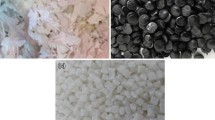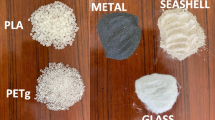Abstract
In recent times, FDM technology has been extensively utilized to reuse small-scale thermoplastic waste materials to produce 3D-printed structures for various engineering applications. However, recycled material such as PET (i.e., waste from beverage bottling) for 3D printing is less explored because of poor mechanical properties due to possible thermal degradation, uncontrolled crystallinity, and shrinkage issues during high fusion temperatures. Hence, the aim of this study is to develop high-quality filament from PET waste for 3D printing purpose. This study involves the investigation of rheological, chemical, thermal, and mechanical behavior of PET filaments produced by different grades of PET plastic waste. The results indicated that filament made from recycled PET (RPET) water bottles and RPET soda bottles have comparable results with virgin PET (VPET) filament samples. The tensile modulus, yield strength, ultimate tensile strength, and tensile strain at break for RPET water bottle and RPET soda bottle made filament are 1932.78 MPa, 47.51 MPa, 52.44 MPa, and 98.86%; and 2009.66 MPa, 43.08 MPa, 46.08 MPa, and 7.46%, respectively. The novel filament produced from PET plastic waste has the capability to replace VPET filaments for fabricating high-quality structural parts through an additive manufacturing approach.








Similar content being viewed by others
Data Availability
All the data required are available within the manuscript.
References
Soong YHV, Sobkowicz MJ, Xie D (2022) Recent Advances in Biological Recycling of Polyethylene Terephthalate (PET) Plastic Wastes. Bioengineering 9(3):1–27. https://doi.org/10.3390/bioengineering9030098
Ahmed T et al (2018) Biodegradation of plastics: current scenario and future prospects for environmental safety. Environ Sci Pollut Res 25(8):7287–7298. https://doi.org/10.1007/s11356-018-1234-9
Mishra V, Negi S, Kar S (2023) FDM-based additive manufacturing of recycled thermoplastics and associated composites. J Mater Cycles Waste Manag 25(2):758–784. https://doi.org/10.1007/s10163-022-01588-2
Mishra V, Negi S, Kar S, Sharma AK, Rajbahadur YNK, Kumar A (2022) Recent advances in fused deposition modeling based additive manufacturing of thermoplastic composite structures: A review. J Thermoplast Compos Mater 36(7):3094–3132. https://doi.org/10.1177/08927057221102857
Stevenson L, Nodet C (2023) Managing plastic waste: Opportunities for Asia-Pacific leadership. The Sustainability Institute by ERM
PlasticsEurope (PEMRG) (2023) Share of global plastic materials produced in Asia from 2014 to 2019. Stat Res Dept. https://www.statista.com. Accessed on 8 May 2023
Ng CH et al (2023) Plastic waste and microplastic issues in Southeast Asia. Front Environ Sci 11. https://doi.org/10.3389/fenvs.2023.1142071
United Nations Environment Programme (2021) From Pollution to Solution: A global assessment of marine litter and plastic pollution. Nairobi. https://www.unep.org/. Accessed on 8 May 2023
Swachh Bharat Mission-Urban (2019) Plastic Waste Management Practices- Issues, solutions & case studies. https://www.swachhbharaturban.gov.in. Accessed on 8 May 2023
Webb HK, Arnott J, Crawford RJ, Ivanova EP (2013) Plastic degradation and its environmental implications with special reference to poly(ethylene terephthalate). Polymers (Basel) 5(1):1–18. https://doi.org/10.3390/polym5010001
Hopewell J, Dvorak R, Kosior E (2009) Plastics recycling: Challenges and opportunities. Philos Trans R Soc B Biol Sci 364(1526):2115–2126. https://doi.org/10.1098/rstb.2008.0311
Torres N, Robin JJ, Boutevin B (2000) Study of thermal and mechanical properties of virgin and recycled poly(ethylene terephthalate) before and after injection molding. Eur Polym J 36(10):2075–2080. https://doi.org/10.1016/S0014-3057(99)00301-8
Viana JC, Alves NM, Mano JF (2004) Morphology and mechanical properties of injection molded poly(ethylene terephthalate). Polym Eng Sci 44(12):2174–2184. https://doi.org/10.1002/pen.20245
Mishra V, Ror CK, Negi S, Kar S, Borah LN (2023) Development of sustainable 3D printing filaments using recycled/virgin ABS blends: Processing and characterization. Polym Eng Sci 63(7):1890–1899. https://doi.org/10.1002/pen.26330
Gwamuri J, Wittbrodt BT, Anzalone NC, Pearce JM (2014) Reversing the trend of large scale and centralization in manufacturing: The case of distributed manufacturing of customizable 3-D-printable self-adjustable glasses. Challenges Sustain 2(1). https://doi.org/10.12924/cis2014.02010030
Woern AL, McCaslin JR, Pringle AM, Pearce JM (2018) RepRapable Recyclebot: Open source 3-D printable extruder for converting plastic to 3-D printing filament. HardwareX 4:e00026. https://doi.org/10.1016/j.ohx.2018.e00026
Petersen E, Kidd R, Pearce J (2017) Impact of DIY home manufacturing with 3D printing on the toy and game market. Technologies 5(3):45. https://doi.org/10.3390/technologies5030045
Petersen E, Pearce J (2017) Emergence of home manufacturing in the developed world: Return on investment for open-source 3-D printers. Technologies 5(1):7. https://doi.org/10.3390/technologies5010007
Wittbrodt BT et al (2013) Life-cycle economic analysis of distributed manufacturing with open-source 3-D printers. Mechatronics 23(6):713–726. https://doi.org/10.1016/j.mechatronics.2013.06.002
Laplume AO, Petersen B, Pearce JM (2016) Global value chains from a 3D printing perspective. J Int Bus Stud 47(5):595–609. https://doi.org/10.1057/jibs.2015.47
Woern AL, Byard DJ, Oakley RB, Fiedler MJ, Snabes SL, Pearce JM (2018) Fused particle fabrication 3-D printing: Recycled materials’ optimization and mechanical properties. Materials (Basel) 11(8):1413. https://doi.org/10.3390/ma11081413
Alexandre A, Cruz Sanchez FA, Boudaoud H, Camargo M, Pearce JM (2020) Mechanical properties of direct waste printing of polylactic acid with universal pellets extruder: Comparison to fused filament fabrication on open-source desktop three-dimensional printers. 3D Print Addit Manuf 7(5):237–247. https://doi.org/10.1089/3dp.2019.0195
Cruz F, Lanza S, Boudaoud H, Hoppe S, Camargo M (2020) Polymer recycling and additive manufacturing in an open source context: Optimization of processes and methods. Proc Ann Int Solid Free Fabr Symp - An Addit Manuf Conf SFF 1591–1600
Anderson I (2017) Mechanical properties of specimens 3D printed with virgin and recycled polylactic acid. 3D Print Addit Manuf 4(2):110–115. https://doi.org/10.1089/3dp.2016.0054
Jukka Pakkanen LI, Manfred Diego, Minetol Paolo (2017) About the use of recycled or biodegradable filaments for sustainability of 3D printing state of the art and research opportunities. SDM Sustain Des Manuf 1:776–785. https://doi.org/10.1007/978-3-319-57078-5
Mohammed MI, Wilson D, Gomez-Kervin E, Vidler C, Rosson L, Long J (2020) The recycling of E-Waste ABS plastics by melt extrusion and 3D printing using solar powered devices as a transformative tool for humanitarian aid. Solid Free Fabr Proc Ann Int Solid Free Fabr Symp - An Addit Manuf Conf SFF 80–92
Chong S, Mohammad GP, Thomas K (2016) Physical characterization and pre-assessment of recycled high-density polyethylene as 3D printing material. J Polym Environ. https://doi.org/10.1007/s10924-016-0793-4
Baechler C, Devuono M, Pearce JM (2013) Distributed recycling of waste polymer into RepRap feedstock. Rapid Prototyp J 19(2):118–125. https://doi.org/10.1108/13552541311302978
Woern A, Pearce J (2017) Distributed manufacturing of flexible products: Technical feasibility and economic viability. Technologies 5(4):71. https://doi.org/10.3390/technologies5040071
Mohammed MI, Wilson D, Gomez-Kervin E, Rosson L, Long J (2019) EcoPrinting: Investigation of solar powered plastic recycling and additive manufacturing for enhanced waste management and sustainable manufacturing. IEEE Conf Technol Sustain SusTech 2018:1–6. https://doi.org/10.1109/SusTech.2018.8671370
Charles A, Bassan PM, Mueller T, Elkaseer A, Scholz SG (2019) On the assessment of thermo-mechanical degradability of multi-recycled ABS polymer for 3D printing applications. Smart Innov Syst Technol 155:363–373. https://doi.org/10.1007/978-981-13-9271-9_30
Little HA, Tanikella NG, Reich MJ, Fiedler MJ, Snabes SL, Pearce JM (2020) Towards distributed recycling with additive manufacturing of PET flake feedstocks. Materials (Basel) 13(19):4273. https://doi.org/10.3390/MA13194273
Bakır AA, Atik R, Özerinç S (2021) Effect of fused deposition modeling process parameters on the mechanical properties of recycled polyethylene terephthalate parts. J Appl Polym Sci 138(3):1–12. https://doi.org/10.1002/app.49709
Zander NE, Gillan M, Lambeth RH (2018) Recycled polyethylene terephthalate as a new FFF feedstock material. Addit Manuf 21(January):174–182. https://doi.org/10.1016/j.addma.2018.03.007
Oussai A, Bártfai Z, Kátai L (2021) Development of 3d printing raw materials from plastic waste. A case study on recycled polyethylene terephthalate. Appl Sci 11(16):7338. https://doi.org/10.3390/app11167338
Bustos Seibert M, Mazzei Capote GA, Gruber M, Volk W, Osswald TA (2022) Manufacturing of a PET filament from recycled material for material extrusion (MEX). Recycling 7(5):69. https://doi.org/10.3390/recycling7050069
Singh RK, Ruj B, Sadhukhan AK, Gupta P (2019) Impact of fast and slow pyrolysis on the degradation of mixed plastic waste: Product yield analysis and their characterization. J Energy Inst 92(6):1647–1657. https://doi.org/10.1016/j.joei.2019.01.009
SP SP, Swaminathan G, Joshi VV (2021) Thermogravimetric analysis of hazardous waste: Pet-coke, by kinetic models and Artificial neural network modeling. Fuel 287:119470. https://doi.org/10.1016/j.fuel.2020.119470
Van de Voorde B et al (2022) Effect of extrusion and fused filament fabrication processing parameters of recycled poly(ethylene terephthalate) on the crystallinity and mechanical properties. Addit Manuf 50(November 2021):102518. https://doi.org/10.1016/j.addma.2021.102518
Mecozzi M, Nisini L (2019) The differentiation of biodegradable and non-biodegradable polyethylene terephthalate (PET) samples by FTIR spectroscopy: A potential support for the structural differentiation of PET in environmental analysis. Infrared Phys Technol 101:119–126. https://doi.org/10.1016/j.infrared.2019.06.008
Phillipson K, Hay JN, Jenkins MJ (2014) Thermal analysis FTIR spectroscopy of poly(ε-caprolactone). Thermochim Acta 595:74–82. https://doi.org/10.1016/j.tca.2014.08.027
Idrees M, Jeelani S, Rangari V (2018) Three-dimensional-printed sustainable biochar-recycled PET composites. ACS Sustain Chem Eng 6(11):13940–13948. https://doi.org/10.1021/acssuschemeng.8b02283
Pirzadeh E, Zadhoush A, Haghighat M (2007) Hydrolytic and thermal degradation of PET fibers and PET granule: The effects of crystallization, temperature, and humidity. J Appl Polym Sci 106(3):1544–1549. https://doi.org/10.1002/app.26788
Jabarin SA, Lofgren EA (1986) Effects of water absorption on physical properties and degree of molecular orientation of poly (ethylene terephthalate). Polym Eng Sci 26(9):620–625. https://doi.org/10.1002/pen.760260907
Acknowledgements
The authors sincerely thank SERB, India, for the financial support under start up research grant (SRG/2021/001647) to conduct this research work at NIT Silchar.
Author information
Authors and Affiliations
Corresponding author
Ethics declarations
Competing interest
The authors declare that they have no known competing financial interests or personal relationships that could have appeared to influence the work reported in this paper.
Additional information
Publisher's Note
Springer Nature remains neutral with regard to jurisdictional claims in published maps and institutional affiliations.
Rights and permissions
Springer Nature or its licensor (e.g. a society or other partner) holds exclusive rights to this article under a publishing agreement with the author(s) or other rightsholder(s); author self-archiving of the accepted manuscript version of this article is solely governed by the terms of such publishing agreement and applicable law.
About this article
Cite this article
Ror, C.K., Negi, S. & Mishra, V. Development and characterization of sustainable 3D printing filaments using post-consumer recycled PET: processing and characterization. J Polym Res 30, 350 (2023). https://doi.org/10.1007/s10965-023-03742-2
Received:
Accepted:
Published:
DOI: https://doi.org/10.1007/s10965-023-03742-2




